Note
Roasted vegetable couscous is a fantastic, flavorful dish that perfectly balances the fluffiness of the grain with the sweet, savory depth achieved by oven-roasting vegetables. It’s a versatile meal or side that’s easy to prepare, adaptable to various palates, and excellent for meal prepping. Mastering this dish is simple with a few key tips, creative serving suggestions, and smart storage techniques.
Essential Tips for a Perfect Roasted Vegetable Couscous
1. Vegetable Roasting Mastery: The key to successful roasting is achieving caramelization, which brings out the natural sugars and intensifies flavor. * Uniformity is Key: Chop all vegetables into roughly the same size (about 1 to 1.5 inches). This ensures they cook evenly.
* Hot Oven, Short Time: Roast at a high temperature, typically between 400∘F and 425∘F (200∘C and 220∘C). This high heat is crucial for browning. Stir them once or twice halfway through the cooking time for even crisping.
* Oil and Seasoning: Toss the vegetables lightly with olive oil (just enough to coat, not soak) and season generously with salt, pepper, and your preferred herbs and spices before roasting.
2. Fluffy Couscous Technique: Couscous is a very quick-cooking grain, and its preparation is often faster than the roasting time.
* Ratio and Rest: The standard ratio for Moroccan (fine) couscous is roughly 1 part couscous to 1.25−1.5 parts boiling liquid (always check your package directions, especially for larger Pearl or Israeli couscous, which requires longer cooking). Pour the boiling liquid over the couscous, cover tightly, and let it sit off the heat for about 5-10 minutes.
* The Fluff: A small addition of olive oil or butter can also aid in the separation.
Serving Tricks and Variations
Roasted Vegetable Couscous is incredibly versatile, lending itself to a myriad of flavor combinations and serving styles.
Serving Tricks for Presentation and Taste:
- Layering: For a visually stunning dish, place the couscous on a large platter first, then arrange the brightly colored roasted vegetables artfully on top.
- The Fresh Finish: The contrast of the fresh herbs with the cooked ingredients adds brightness.
- Sauce Element: A simple dressing transforms the dish from a basic side to an elevated meal. A light lemon-tahini dressing, a zesty red wine vinaigrette, or a Mediterranean blend of olive oil, lemon juice, garlic, and oregano are excellent choices. Drizzle the dressing over the warm couscous to allow the grain to fully absorb the flavors.
Creative Variations:
- Moroccan Spice: Incorporate spices like cumin, coriander, cinnamon, and a pinch of cayenne or harissa paste into the roasting vegetables. Add chickpeas for protein, and garnish with toasted slivered almonds and dried fruit like apricots or raisins.
- Winter Warmth: Season with smoked paprika and maple syrup (or honey) before roasting. Finish with toasted walnuts and a splash of balsamic glaze.
- Protein Boost: Transform it into a hearty main dish by mixing in protein. Cooked chickpeas, cannellini beans, lentils, crumbled tofu, or grilled chicken/salmon all pair beautifully.
Storage and Reheating
One of the great advantages of roasted vegetable couscous is its suitability for batch cooking and meal preparation.
- Freezing (Not Recommended for Best Texture): While possible, freezing couscous is generally not recommended as the texture can become mushy upon thawing. It’s best consumed within the refrigerator timeline.
Reheating and Serving Leftovers:
- Enjoy Cold: This dish is delicious served cold or at room temperature, making it ideal for picnics, packed lunches, or summer gatherings.
- Reheating: When reheating, it’s a good idea to add a splash of vegetable broth, water, or a fresh drizzle of olive oil, as the couscous grains can dry out slightly in the fridge. Fluff again with a fork after warming.
- Revitalization: Before serving leftovers, revitalise the flavor with a fresh sprinkle of herbs, a squeeze of lemon juice, or a dollop of fresh plain yogurt or tzatziki.
Conclusion
Roasted vegetable couscous is more than just a simple side; it’s a canvas for culinary creativity, blending the satisfying texture of couscous with the intense, natural sweetness of roasted vegetables.
By adhering to key roasting and cooking tips, experimenting with global flavor variations, and employing smart storage practices, you can consistently deliver a delicious, healthy, and visually appealing dish that serves equally well as a light lunch, a vibrant
side, or a hearty vegetarian main course. Its ease of preparation and excellent keeping qualities solidify its place as a practical favorite in any busy kitchen.

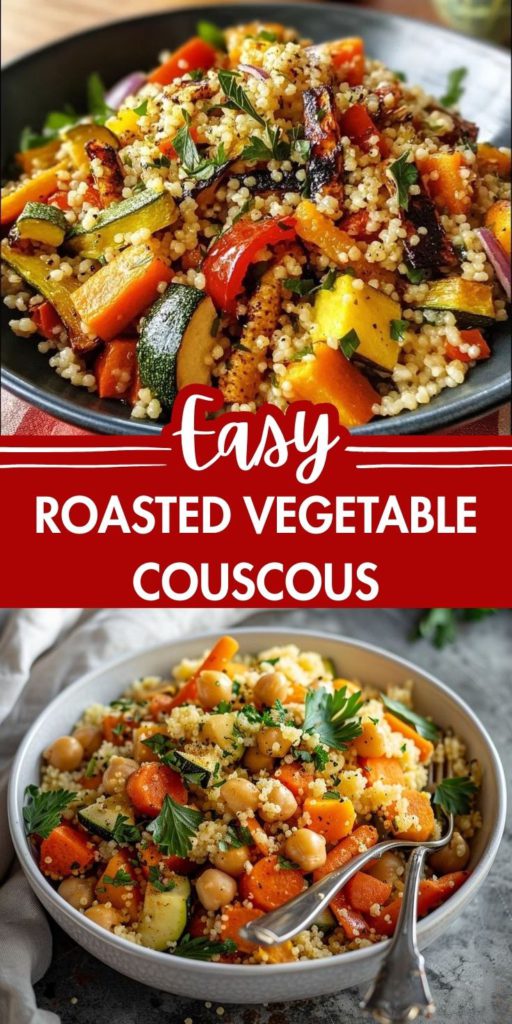
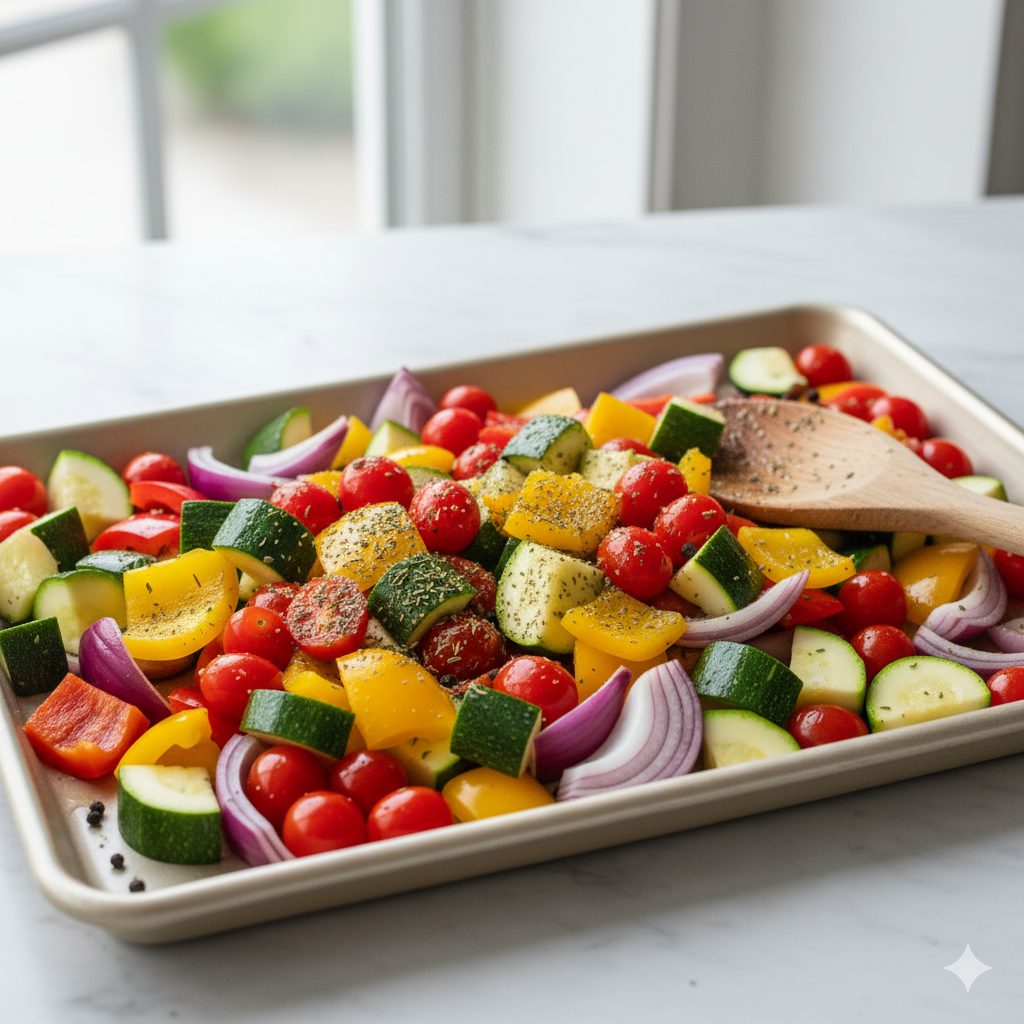 Start by heating your oven to a high temperature of 425∘ F (220∘C). Select your preferred vegetables—a mix of bell peppers (any color), zucchini, and red onion works well. Dice the vegetables so that all the pieces are of comparable size, approximately 1 inch. Cutting them similarly is vital to ensure every piece cooks through evenly. Spread the diced vegetables onto a baking sheet, making sure the pan is not overcrowded. Drench with two tablespoons of olive oil. For flavor, sprinkle on one teaspoon of dried Italian seasoning or a mix of herbs such as oregano and thyme, along with a generous half teaspoon of sea salt and a pinch of ground black pepper. Combine all ingredients thoroughly, ensuring the oil and seasonings cover every piece of produce.
Start by heating your oven to a high temperature of 425∘ F (220∘C). Select your preferred vegetables—a mix of bell peppers (any color), zucchini, and red onion works well. Dice the vegetables so that all the pieces are of comparable size, approximately 1 inch. Cutting them similarly is vital to ensure every piece cooks through evenly. Spread the diced vegetables onto a baking sheet, making sure the pan is not overcrowded. Drench with two tablespoons of olive oil. For flavor, sprinkle on one teaspoon of dried Italian seasoning or a mix of herbs such as oregano and thyme, along with a generous half teaspoon of sea salt and a pinch of ground black pepper. Combine all ingredients thoroughly, ensuring the oil and seasonings cover every piece of produce.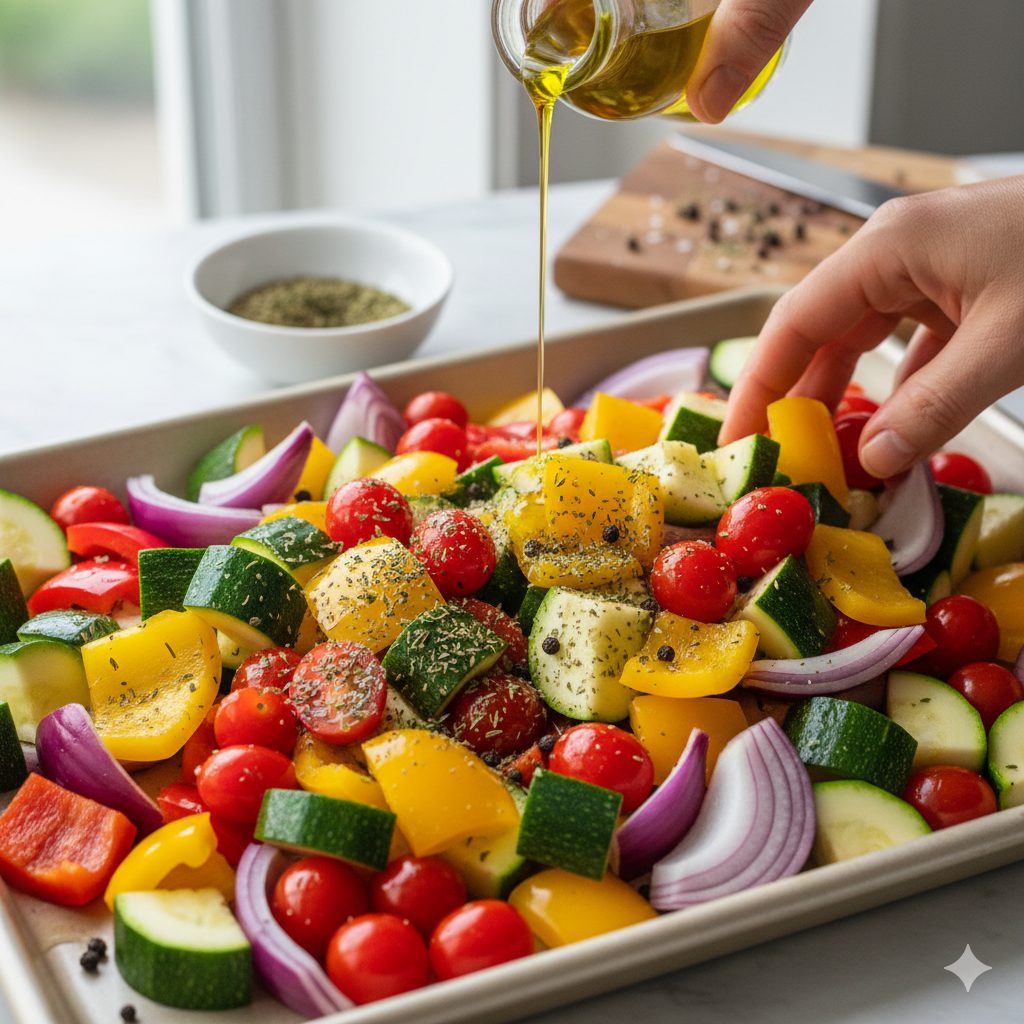 While the vegetables are in the oven, focus on the couscous's moisture. Measure out one and a half cups of vegetable stock or broth—this flavorful base will be absorbed by the grain. Bring this liquid to a rolling boil in a small pot on your stovetop. Using stock instead of plain water is key to building a deeper flavor foundation.
While the vegetables are in the oven, focus on the couscous's moisture. Measure out one and a half cups of vegetable stock or broth—this flavorful base will be absorbed by the grain. Bring this liquid to a rolling boil in a small pot on your stovetop. Using stock instead of plain water is key to building a deeper flavor foundation.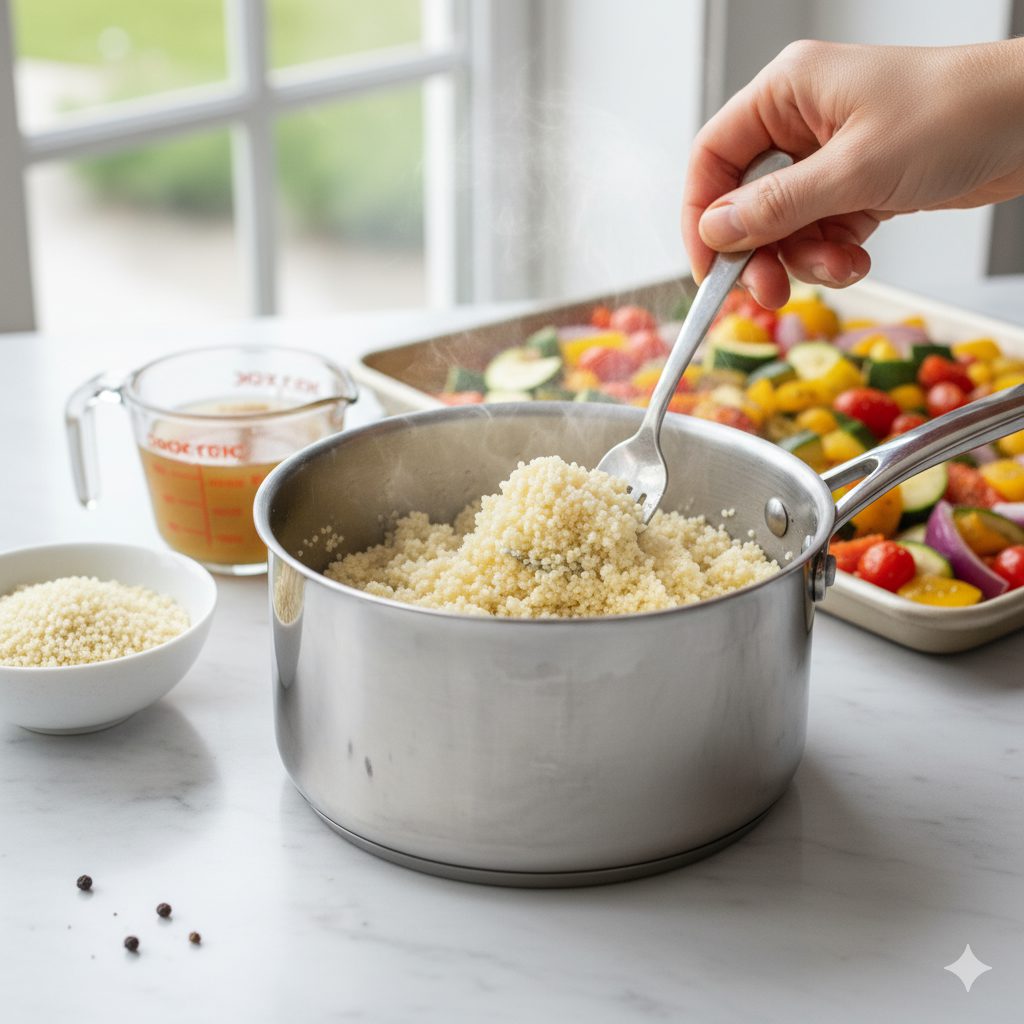 Pour one cup of the dry couscous into a sturdy bowl. Once the stock is actively boiling, immediately pour all the hot liquid over the grains. Stir briefly, then quickly cover the bowl with a tight lid or aluminum foil. The pot should be moved off the heat entirely. Allow the covered mixture to stand without interruption for a full five minutes, or as directed by the packaging. It is important that you do not lift the cover during this phase to allow the steam to properly soften the grain.
Pour one cup of the dry couscous into a sturdy bowl. Once the stock is actively boiling, immediately pour all the hot liquid over the grains. Stir briefly, then quickly cover the bowl with a tight lid or aluminum foil. The pot should be moved off the heat entirely. Allow the covered mixture to stand without interruption for a full five minutes, or as directed by the packaging. It is important that you do not lift the cover during this phase to allow the steam to properly soften the grain.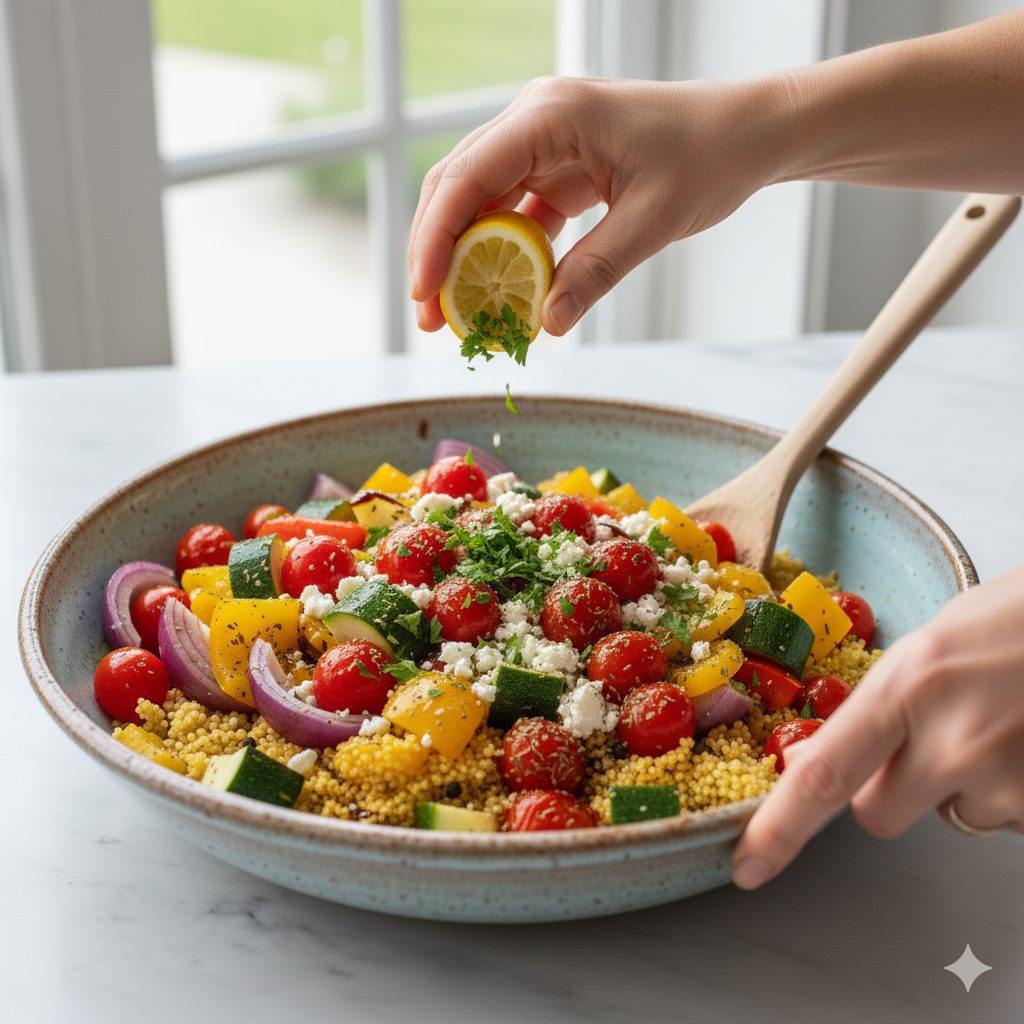 Take a moment to taste the final mixture and adjust the flavor profile as needed, adding extra salt, pepper, or a bit more lemon juice. To complete the presentation, you may drizzle a little extra virgin olive oil over the top and scatter a handful of toasted pine nuts or sunflower seeds for crunch. Present this dish immediately, serving it warm as a satisfying vegetarian entrée or a colorful and filling accompaniment to any main meal.
Take a moment to taste the final mixture and adjust the flavor profile as needed, adding extra salt, pepper, or a bit more lemon juice. To complete the presentation, you may drizzle a little extra virgin olive oil over the top and scatter a handful of toasted pine nuts or sunflower seeds for crunch. Present this dish immediately, serving it warm as a satisfying vegetarian entrée or a colorful and filling accompaniment to any main meal.

